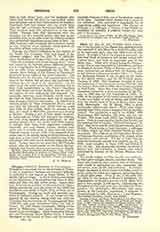

Chios (Gr.Chios, It. Scio, Turkish, Sakiz Adassi), one of the Sporades in the Aegean Sea, separated from the mainland of Asia Minor by a strait five miles wide in its narrowest part; also the chief town of this island. Its origin is lost in the remotest antiquity. In historical times it became a rich Ionian colony with a great navy, and took an important part in the Medic wars. Allied with Athens during the Peloponnesian War, it was conquered by Lacedaemon, wavered in allegiance between Philip of Macedon and the Persians, entered into an alliance with the Romans, and at last became a Roman possession (70 B.C.). Under the Byzantine Empire it was ravaged by the Arabs in the eighth century, and by the Turkish pirate, Tsachas, in 1089. The Venetians occupied it from the beginning of the thirteenth century till 1261, and the Genoese from 1346 to 1566, when it was conquered by Piali Pasha. Since then it has remained a Turkish possession, except for a short occupation by the Tuscans in 1595, and by the Venetians in 1694. In 1822, on the occasion of the Greek insurrection, 30,000 Greeks were killed or sold as slaves, and 20,000 fled from the island, most of them to Syros, where they built Hermopolis. On March 22, 1881, a great earthquake afflicted the island. With some neighboring islets Chios forms a sanjak of the archipelago vilayet. The population is said to be 60,000: 1500 Mussuhnans, 400 Catholics, 250 Jews, and the rest Greeks. The town itself (Scio) has 15,000 inhabitants. Chios is a metropolitan see for the Greeks (see the episcopal list in Lequien, “Oriens Christianus”, I, 931); they have several churches and schools, and a library. There is also a Latin bishopric, a suffragan of Naxos, which has three churches served by some ten priests. The religious are the Capuchins, Brothers of Christian Doctrine, and Sisters of St. Joseph of the Apparition, with schools. The list of Latin bishops since the fourteenth century is in Lequien, op. cit., II, 1062; more complete in Gams (448) and Eubel, I, 191; II, 141. The diocese also includes the island of Samos, with 100 Catholics, a church, and school conducted by Fathers of the African Missions from Lyons.
The fertile valleys of Chios are like vast orchards, in which grow oranges, lemons, and other fruits. The island also produces wine, mastic, resin of a lentiscus, used chiefly in perfuming the raki, turpentine, silk and cotton, wax, marble, and antimony. In extreme length the island is about thirty-two miles, north to south, and at its widest part eighteen, narrowing down to about eight miles. Chios is one of the sites that lay claim to the honor of Homer’s birthplace; the Dascalopetra, or Homer’s school, a rock where he is said to have taught, is still shown. Chios is also the birthplace of the tragic poet Ion, the historian Theopompus, the philosopher Metrodorus, and many artists; of the Catholics, Giustiniani, a defender of Constantinople in 1453, Leo Allatius (q.v.), and Pepanos; the Greeks, Coresios, Corals, and others.
S. PETRIDES

